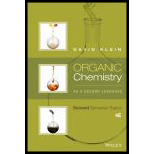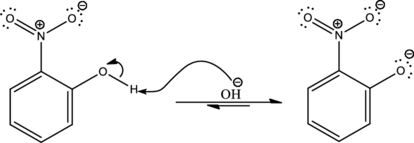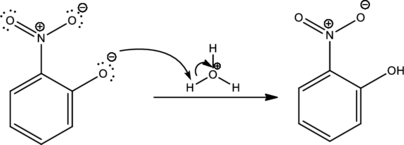
Concept explainers
Propose a mechanism for each of the following reactions:

Interpretation:
Mechanism for the given transformation has to be proposed.

Explanation of Solution
Given reaction is,

Mechanism:
Looking into the reaction it is found that the nucleophile is a strong one namely hydroxide and the reactant has all the three important criteria to undergo
First step is the attack of nucleophile on the carbon atom that bears that chlorine atom which is a leaving group resulting in formation of Meisenheimer complex.

The formed Meisenheimer complex has the following resonance structures.

Second step is the expelling of the leaving group to give the product.

As the given condition is basic, deprotonation takes place.

Under acidic condition the formed ion is protonated to give the product. This is the reason for using acid in order to complete the reaction.

Complete mechanism can be given as shown below,

Mechanism for the given transformation is proposed.
Want to see more full solutions like this?
Chapter 5 Solutions
Organic Chemistry As a Second Language: Second Semester Topics
Additional Science Textbook Solutions
Chemistry & Chemical Reactivity
Basic Chemistry (5th Edition)
Living by Chemistry
Introductory Chemistry (5th Edition) (Standalone Book)
Living By Chemistry: First Edition Textbook
Essential Organic Chemistry (3rd Edition)
- The Meerwein-Ponndorf-Verley reaction involves reduction of a ketone by treatment with an excess of aluminum triisopropoxide, [(CH3)2CHO]3Al. The mechanism of the process is closely related to the Cannizzaro reaction in that a hydride ion acts as a leaving group. Propose a mechanism.arrow_forwardShow the products you would obtain by acid-catalyzed reaction of cyclohexanone with ethylamine, CH3CH2NH2, and with diethylamine, (CH3CH2) 2NH.arrow_forwardIf methanol rather than water is added at the end of a Hell-Volhard-Zelinskii reaction, an ester rather than an acid is produced. Show how you would carry out the following transformation, and propose a mechanism for the ester-forming step.arrow_forward
- Treatment of p-tert-butylphenol with a strong acid such as H2SO4 yields phenol and 2-methylpropene. Propose a mechanism.arrow_forwardTreatment of 1-aminoadamantane, C10H17N, with methyl 2,4-dibromobutanoate in the presence of a nonnucleophilic base, R3N, involves two successive SN2 reactions and gives compound A. Propose a structural formula for compound A.arrow_forwardPropose a structure for the product with formula C9H17N that results when 2-(2-cyanoethyl)cyclohexanone is reduced catalytically.arrow_forward
- Knoevenagel condensation is a reaction involving an active methylene compound (a CH2 flanked by two electron-withdrawing groups) and an aldehyde and ketone. Propose a mechanism for the reaction below.arrow_forwardSolvolysis of the following bicyclic compound in acetic acid gives a mixture of products, two of which are shown. The leaving group is the anion of a sulfonic acid, ArSO3H. A sulfonic acid is a strong acid, and its anion, ArSO3, is a weak base and a good leaving group. Propose a mechanism for this reaction.arrow_forwardAcid-catalyzed hydrolysis of the following epoxide gives a trans diol. Of the two possible trans diols, only one is formed. How do you account for this stereoselectivity?arrow_forward
- Following are the steps in one of the several published syntheses of frontalin, a pheromone of the western pine beetle. (a) Propose reagents for Steps 18. (b) Propose a mechanism for the cyclization of the ketodiol from Step 8 to frontalin.arrow_forwardPropose a mechanism for the following reactionsarrow_forwardpropose a mechanism for the following transformationsarrow_forward

 Organic ChemistryChemistryISBN:9781305580350Author:William H. Brown, Brent L. Iverson, Eric Anslyn, Christopher S. FootePublisher:Cengage Learning
Organic ChemistryChemistryISBN:9781305580350Author:William H. Brown, Brent L. Iverson, Eric Anslyn, Christopher S. FootePublisher:Cengage Learning

